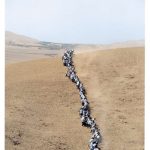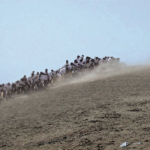- When Faith Moves Mountains
- When Faith Moves Mountains
“Five hundred volunteers with shovels gathered at a huge sand dune on the outskirts of Lima, Peru, and over the course of a day moved it by several inches. Alÿs developed the idea after first visiting Lima in October 2000. The political context was inescapable: “This was during the last months of the Fujimori dictatorship. Lima was in turmoil with clashes on the streets, obvious social tension and an emerging movement of resistance. This was a desperate situation calling for an epic response: staging a social allegory to fit the circumstances seemed more appropriate than engaging in a sculptural exercise.” The principle that drove When Faith Moves Mountains was “maximum effort, minimal result.” The most apparently minimal change was effected, and only by means of the most massive of collective efforts.
The action itself, as documented in photographs and video, is extraordinarily impressive, but in the end the “social allegory” takes over from the work’s undeniable formal presence. The action was completely transitory. The next day, no one could recognize that the huge sand dune had been moved. The true aftermath of the work lies in the ripples of anecdote and image that radiate out from it.” [credit]

